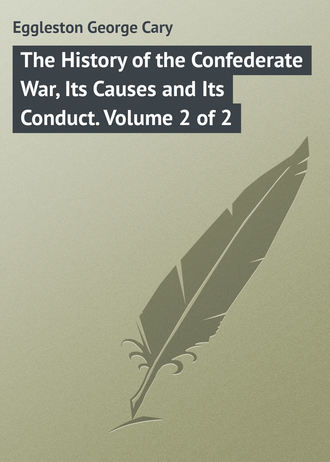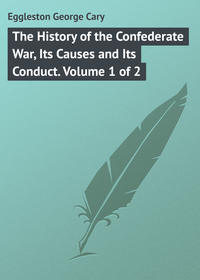 полная версия
полная версияThe History of the Confederate War, Its Causes and Its Conduct. Volume 2 of 2
Now for the first time in the entire history of the war a single masterful mind was in control of all the operations of all the vast armies of the United States, and was trying to direct all those operations with singleness of purpose to a foreordained end. The coming of Grant into command thus marks an epoch in the history of the war.
Some of his lieutenants did their work incompetently, thus in a degree baffling his purpose, but in the main those whom he had wisely selected for command did that which he required of them in masterly fashion. Sigel, who was to advance up the Valley of Virginia, and break the communications between Tennessee and the Confederate capital, failed utterly. In profound disgust, General Grant received from Halleck a dispatch saying, "Sigel is in full retreat on Strasbourg. He will do nothing but run; never did anything else."
Banks also failed to place his army of 40,000 men at New Orleans in time to help in the grand strategy which Grant had inaugurated.
Butler got himself "bottled up," as General Grant phrased it, on the south side of the James river, so that while he held a strong defensive position there, he was unable to employ his troops aggressively with effect. But the rest of Grant's subordinates – and especially Sherman – carried out their orders with brilliant capacity and tremendous effect.
While Grant was thus preparing for his grand campaign, the Confederates were not idle. With forces greatly inferior in number and equipment, and with an exhausted country behind him, Lee stood upon the defensive, waiting to see what his adversary might undertake, and what opportunities might open themselves to him for offensive defense.
In the meanwhile that most active and tireless of campaigners, General N. B. Forrest, went upon a raid in West Tennessee and Kentucky which, for a time, seriously threatened an invasion of the North and a disturbance of General Grant's plans. Sweeping northward like a hurricane, Forrest captured the Federal garrison of 500 men at Union City in Tennessee, wrecked railroads in every direction, and pushed his column daringly to Paducah, Kentucky, on the banks of the Ohio, fifty miles above Cairo. Sherman sent all his cavalry and other available troops to check this movement, and if possible to make an end of Forrest by capturing him and his force. But Forrest was too quick for him. Rapidly falling back, he assailed the Federal fort on the Mississippi river, known as Fort Pillow. That fortress was held by negro troops, and the Southerners had never yet consented to regard the employment of such troops as legitimate in this war.
Here it is necessary to explain. The enlistment of negroes in military service was no new thing in American war. During the Revolution, and even before it, the statutes of South Carolina and of some of the other colonies specifically provided for such enlistments, and in South Carolina, at least, the law made it an offense for the master of any slave to refuse his service to the country as a soldier. Again during the war of 1812–1815, Andrew Jackson made free use of vigorous young negroes, enlisting them as soldiers wherever he could find them, and appealing to their patriotism to support with manly determination the independence of the only country they could call their own.
But in the Confederate war a different condition of affairs existed. From the beginning of the struggle the Confederates employed negroes to work upon fortifications, and although they did not enlist them as soldiers, this employment of them amounted to much the same thing in so far as it released an equal number of enlisted men for active work in the field. So general was the prejudice against any and every recognition of negro equality at the North as well as at the South, that many newspaper writers at the North – ignorant of the history of their own country with respect to the military employment of negroes – bitterly denounced all this, insisting that the Confederates were employing savages in arms against a civilized enemy. That plea was apt to be an effective one in this country, for the reason that from the beginning of the colonial struggles until the end of the war of 1812–1815 it had been one of America's grievances against Great Britain that agents of the mother country had mercilessly employed Red Indian savages in murderous warfare upon the white men.
When, later in the war, it was decided at the North to arm and use as soldiers such able-bodied negroes as might be induced to volunteer, the recruits were naturally drawn in the main from the large companies of runaway slaves who had escaped into the Federal lines. This fact gave to the military employment of negroes against the South the aspect of an attempt to create a servile insurrection and war – the one thing which had been always most dreaded in those states in which the negroes outnumbered the whites. Servile insurrection was understood to mean rapine, the burning of homes, the butchery of women and little children, and all else of horror that savage warfare may signify. The Southerners therefore held the enlistment of negroes in the Northern armies to be an act of unforgivable vandalism and savagery. They peremptorily refused to recognize the negro anywhere as a soldier, or in case of his capture to treat him as a prisoner of war.
In execution of that purpose of absolute and unflinching historical truthfulness which the author of this work has tried to make his only inspiration, it must be said that in many cases, and particularly on occasions of raids into undefended country, certain of the negro troops did many things to justify the Southern view of the iniquity of their employment against white men. In regions undefended they frequently committed outrages of a kind which the instincts of humanity never forgive.
It is proper here to emphasize again the fact to which the present historian directed earnest attention in a work published in 1874 – namely, that throughout the war, when all the Southern white men were in the field, and when all the plantations with the women and children inhabiting their homes were unprotected, the negro slaves who remained upon the plantations were affectionately loyal and obedient, nowhere instituting insurrection or in any other wise betraying the trust reposed in their fidelity and affection, and this in spite of the fact that they perfectly knew that the failure of the South in the War must result in their own emancipation. Emphasis is here given to this fact in order that nothing recorded concerning the atrocities committed by certain negro troops shall impair or reflect upon the negro character generally.
But from beginning to end the Confederates refused to recognize the right of their enemy to enlist their runaway slaves in the war against them. From first to last they refused to regard negroes as soldiers, entitled to be treated as such. So returning to our theme, it must be said that when Forrest found Fort Pillow garrisoned chiefly by negro troops, even had he desired it to be otherwise, he could not have prevented the slaughter that ensued. His men simply would not make prisoners of war out of negroes in arms, and the result of the struggle was a Federal loss of about 500 killed together with nearly all their officers, while the Confederates according to Forrest's report lost only about twenty men. In his dispatches, written at that time of excitement, Forrest said, "It is hoped that these facts will demonstrate to the Northern people that negro soldiers cannot cope with Southerners." His words have since been construed to mean a blood-thirsty antagonism to the negroes. That construction may be correct, but General Forrest himself contended to the end of his life that he meant only to point out the ease with which Southern soldiers conquered and destroyed this negro force as illustrating the inefficiency of black men in fighting white men. That meaning would seem to be the only one which it is necessary to give to the language of his dispatch.
Other minor operations during the period of preparation for the tremendous struggle of 1864 were carried on in different parts of the South with results that had no important bearing upon the general course of the contest or upon its outcome. These operations need not be more particularly mentioned here.
CHAPTER XLIV
Grant's Plan of Campaign
As the month of April neared its end Grant prepared to execute the plans he had so laboriously formed, and for which he had given to all his lieutenants in every quarter of the country orders as minute as they could be made without risk of leaving any lieutenant embarrassed for want of liberty of action in the event of an emergency.
For the sake of a clear understanding let us state again in brief outline his scheme of operation. His fundamental conception was that in order to conquer the Confederacy he must destroy its armies in the field, and especially Lee's army, which had been from the first the chief source and center of danger to the Federal cause, both by reason of its superb fighting quality, and by reason of the masterful genius of Lee that directed it. Grant's first care, therefore, was so to employ all the subsidiary forces in all quarters of the South as to prevent the sending of any reinforcements to Lee.
His second fundamental idea was to fight the Confederate armies in the open field rather than assail them in defensive works at the points of chief strategic importance.
Certain writers for the press have severely criticized the great Federal commander for having wasted thousands of lives in his march overland upon Richmond instead of transferring his army to the front of that city by water as he might easily have done without the loss of a man. This criticism is ignorant in the extreme, but as its conclusions persist in spite of Grant's own, and many other intelligent replies, it seems necessary to say again that his purpose was not to reach the front of Richmond, but to encounter, and if possible, to crush Lee's army in the field. It is perfectly true that he might have placed the Army of the Potomac in front of Richmond and Petersburg without any battling or any loss of life, just as McClellan had done in 1862. But in that case his task would have been to assail the greatest general of the Confederate army, the greatest engineer of modern times, and the strongest fighting force of the South in positions of their own choosing, defended by the most formidable defensive works that ingenuity could construct. It was Grant's idea, and a perfectly sound one, that he could not afford this – that this was the longest and most difficult instead of the shortest and easiest road to the accomplishment of his military purposes. He had two men to Lee's one; he could get two more for the asking where Lee could not get another one. He wisely decided, therefore, that if possible he would compel Lee to fight in the open field, instead of confronting him in defensive works. It was not certain that he could compel Lee to this course. But it was his purpose to do so if possible, and in the end he succeeded in achieving that possibility.
Rightly interpreted, there was no greater strategy in all the war than this. Yet nothing has been more misunderstood or more injuriously reported. In his uncertainty as to whether Lee would accept battle in the open field, or would fall back upon Richmond and defend that city behind strong earthworks, Grant prepared himself for either contingency. He ordered Butler, with a strongly reinforced army, to move up the southern side of James river, supported by the gunboats, and to establish himself in an unassailable position, from which, in case of Lee's declining battle in the open, he might threaten or assail the southern and eastern defenses of the Confederate capital, while Grant, with the Army of the Potomac, might fall upon that city from the North, thus bringing to bear against Lee a combined force three or four times as great as his own.
But his strong hope was that Lee would accept battle in the field, and that the Confederate general might be so far crippled there by the assaults of overwhelming numbers as to be far less formidable in his final defense of Richmond than he must be if forced back to that position by maneuvering and without fighting.
If there was any error or miscalculation in General Grant's plan for the destruction of the Confederacy and the ending of the war, that error was in underestimating the tremendous fighting force of the Army of Northern Virginia, under command of Robert E. Lee. Grant had never met Lee in battle, and had learned of his capacity and of the resisting power of the army under his command only by hearsay. These were so much greater than anything else of the kind that had been known in the war that Grant's mistake, if he made any mistake, was surely pardonable. He had reckoned rightly in supposing that Sherman could deal successfully with Johnston, could take Atlanta, and could push his army thence to the sea, again cutting in twain what remained of the Confederacy. Perhaps he had not fully appreciated the resisting capacity of Lee with his Army of Northern Virginia. Perhaps he had a trifle too confidently reckoned upon numbers as a means of crushing that force. At any rate in his tremendous campaign from the Wilderness to Petersburg, he did not conquer it or crush it. So far indeed did he fail to do this, that after Lee had retired to Richmond and Petersburg and there confronted Grant's enormously reinforced army, the Confederate general was able to reinforce Early in the valley and send him on an expedition northward which threw Washington again into a panic, and for a time threatened the compulsory withdrawal of a part of Grant's forces from the siege of Richmond and Petersburg.
In all his plans Grant calculated, as he had an entire right to do, upon an enormous superiority of force, whether measured by the number of men under his command, or by the extent of equipment, or by the perfection of his supply departments or by the limitless reinforcement which he was privileged to call to his aid, where his adversary was forbidden by strenuous circumstance, to add a single brigade or regiment or company or man to his fighting force.
It was his plan to hurl against Lee a force so overwhelming that in the ordinary calculations of war it should crush him completely. To that end he ordered Meade on the twenty-seventh of April to advance with his entire army from the position he occupied near Bull Run to the Rappahannock. On the same day he ordered Burnside, who lay at Annapolis with 20,000 men, to advance and occupy Meade's former position, thus bringing to bear the whole of the forces in northern Virginia as a column of offense against Lee.
At the same time Grant ordered Butler to push up on the south side of the James river, and secure a strong and threatening position in rear of the Richmond defenses. Reinforcements were held ready to go to Butler's aid in the event that Lee should fall back upon the defenses of the Confederate capital.
On the same day Sherman was directed from Grant's headquarters to mass his forces and begin that splendid advance against Johnston and Atlanta, which was intended first to neutralize and then to destroy the only great Confederate army other than Lee's which remained in the field. Other and minor operations were ordered from the Valley of Virginia, from West Virginia, from eastern Tennessee, from New Orleans and from other points, all of which were intended to accomplish two purposes – one of them the interruption of Confederate communications, and the other to prevent the sending of any reinforcements to Lee.
General Grant has himself frankly stated in his "Memoirs," page 419, that "to get possession of Lee's army was the first great object. With the capture of his army Richmond would necessarily follow." Here we have the purpose of the campaign in a nutshell. If General Grant could have succeeded in capturing Lee's army or destroying it in the field, there is no possible doubt whatever that Richmond would have followed, as he said, and the Confederate resistance would have ended early in the summer of 1864. For Sherman's operations against Johnston, Atlanta and the far South were completely successful, as we shall see hereafter. The resisting capacity of the Confederacy was prolonged solely through the fact that Grant's hope of quickly capturing or destroying Lee's army was baffled for the time, and postponed to another year.
General Grant has himself explained the immediate strategy employed by him in his campaign in northern Virginia. He had his choice between two courses, – either to move continuously by his own left flank around Lee's right, thus keeping always at his back that great system of waterways beginning in the Rappahannock and Potomac, and stretching on to Fortress Monroe and the James, and maintaining at all times in his rear a perfect and unassailable base of communications and supplies; or, on the other hand, to move by his own right flank around Lee's left, as Hooker had tried to do, thus threatening the Confederate communications, and forcing Lee, as it were, into a pocket. Should he adopt this second course, however, he must carry with him all that he needed of ammunition and food supplies, and expose his own communications to possible rupture at any hour by daring operations on the part of the Confederate forces. He determined, therefore, to move by his own left, assailing Lee's right and keeping the waterways always at his back.
The plan was simple and effective. It is true that it left some advantages to Lee – unmolested communications and short lines of march – but these were more than offset by the other considerations involved. From beginning to end of the struggle Grant found no occasion to change his method in the least.
CHAPTER XLV
The Battles in the Wilderness
With the coming of May, 1864, the two great commanding geniuses of the War – Lee and Grant – met each other in conflict. The exact forces commanded by each have never been ascertained. But the estimates of the various writers on the subject, North and South, do not differ sufficiently, to make their differences of much consequence. In round numbers Lee had, on the Rapidan, about 66,000 men. The army with which Grant opposed him numbered approximately 120,000. These estimates do not include either the Confederate forces defending Richmond and Petersburg on the one hand, or Butler's strong army south of the James on the other. Lee had called Longstreet back from the region of Atlanta, and had thus in effect massed all the force that he could hope to employ in that campaign. With this force substantially half as large as that of his adversary, he determined to accept Grant's offer of battle in the field. To that end he moved his army on the second of May to the western edge of that peculiar region known as the Wilderness. There he awaited the coming of Grant.
This Wilderness, it should be explained, is a region of peculiar difficulty by reason of the tangled mass of second growths which have replaced the original forest, cut away a century or more ago as fuel for iron works. In extent the region is about a dozen miles wide in either direction. It borders the Rapidan, and extends to the open country in front of Chancellorsville, where the battle of that name had been fought a year before.
At midnight on the third of May the Army of the Potomac crossed the Rapidan on five pontoon bridges, and marched at once into the Wilderness, where it remained during the whole of the fourth in order that its enormous train of 4,000 wagons and the reserve artillery of more than 100 guns might be protected in their passage across the river. It was Grant's hope to move by his left flank, out of the Wilderness, passing around his enemy, and placing himself with all his force between that enemy and the Confederate capital. But with that promptitude which was characteristic of all his operations, Lee anticipated this movement and struck at Grant's flank early on the morning of the fifth.
The assault was made in the midst of the Wilderness – in a thicket so dense that it was impossible at many points for the men on one side to see those on the other, a hundred feet away. Every forward or backward movement involved a struggle through a tangle of vines and underbrush and young forest growths so thickly standing as to render all progress difficult, and all regularity of formation impossible. On either side no corps or regiment or company could know what its own friends were doing on its right or its left; no officer could tell whether he was being supported on his flank or had been abandoned there; no steadiness or cohesion was possible. No alignment could be maintained. It is doubtful to-day that any officer on either side in that struggle, from Grant and Lee at the top to the smallest commander at the other end of the line, ever had a clear-cut idea of the course that that day's fighting took. It consisted of a series of irregular assaults made with desperate valor, and repelled with equal determination. It resembled nothing so much as a battle in the dark, the one thing which all commanders most dread, and most sedulously avoid.
Very naturally the fighting was at short range at every point. Scarcely anywhere on that tangled field did the opposing forces discover each other's positions until they came within short pistol-shot range. The slaughter was therefore tremendous and at no time could either commanding general fully satisfy himself as to how the battle was going or what its result was likely to be or even what his own or the enemy's position was.
The two greatest fighting machines that America has yet produced had met in battle, in the midst of such a maze of tangled growths as nowhere else exists except in marshes where such a meeting is impossible by reason of a lack of firm ground for the men to stand upon. Here at least, there was firm ground.
Grant had not expected to encounter his enemy here. He had supposed that Lee would move out of the Wilderness and choose more favorable ground upon which to receive the assaults of his enemy. Accordingly, the Federal commander had already pushed a part of his army under Hancock toward the edge of the Wilderness, hoping by a rapid march to place it between the Confederate army and the Confederate capital. No sooner, however, was Lee's assault developed than Grant saw clearly that he must fight a determined battle here on this most unsuitable ground. Lee had decided this in the obvious expectation of finding Grant unready. But readiness under all circumstances was a part and an important part of Grant's character and intellectual make-up. It was his habit of mind to take things as he found them and to do the best he could in every case. He hurriedly called Hancock back and accepted battle in the jungle.
The fighting was desperate throughout the day, and at the day's end no decisive advantage rested with either party. Lee had been fighting with only a part of his army, for the reason that Longstreet with that first corps upon which Lee always relied for the more desperate work of war did not reach position in time to take part in the struggle of that day.
At nightfall it was obvious that the contest must be resumed in the morning and indeed, each of the great commanders intended that it should be, each planning to strike first if possible. In preparation for the coming morning's work both sides spent the night in diligent fortifying with such means as were at hand.
Grant ordered an assault all along the line to be made at five o'clock in the morning. Lee, still more alert, struck out with his left an hour earlier. He was still weak on his right wing, for lack of Longstreet, who had not yet come up. Grant, recognizing this fact, planned to hurl Hancock upon the Confederate right at the appointed hour of five o'clock in the morning. By an adroit handling of Rosser's cavalry, the Confederates managed to deceive Hancock into the belief that Longstreet was making a flank movement against the Federal left, similar to those which Jackson had made with such destructive effect in former battles. To meet this and to avoid a disaster like that which had befallen Hooker at Chancellorsville, Hancock promptly detached a considerable part of his force, and sent it to his left, thus weakening his column of attack.
Nevertheless he struck hard enough to drive back the weak Confederate right for more than a mile. Then Longstreet, who had undertaken no such flanking expedition as that which Hancock had supposed, came up and threw his veterans precipitately upon his foe.









